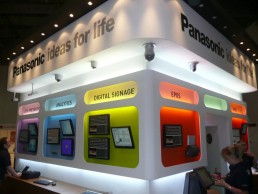Top tips from a designer on how to create a WOW (Not an OW) exhibition stand
As an experienced design agency, with a focus on high-quality design solutions, it saddens us to see marketers misled with design proposals that promise the earth and then fail to live up to those expectations. In many cases, visuals can provide an initial “WOW” factor, but as an experienced design agency, we know all too well how misleading visuals can be. Being unaware of, or not recognising the crucial questions to ask at the proposal stage can result in an exhibition stand or roadshow being a very inadequate representation of the original visual presented. Now, we are not privy to the budgets clients allocate to the design and build of their exhibition stand solutions. Even so, we are often shocked at just how many stands are ill-considered, poorly executed and surprisingly inferior representations of their visuals.
There are companies offering exhibition design services with either limited experience, no real design skills or possibly trying to “add on” this feature to their marketing services. Marketing agencies may either attempt to create your stand themselves or outsource it to a supplier they have found on Google Search. With limited specialist skills they will concentrate their efforts on the proposal stage and possibly try to “Wow” you with a great visual. However, exhibition design is a specialised discipline and requires a professional company with knowledge and experience in this field. I’m not saying that if you see a great visual that it will always result in a crudely produced stand. However, asking a few of the following important questions at the concept stage might just to save you problems onsite or an awkward conversation with your boss.
We are proud to say our completed solutions at SHAPES are always an enhancement of our visuals – never the other way round. A visual need not be an absolute representation of the end product, as it is only an impression of what your stand or roadshow should resemble when built. However, some businesses will focus all their efforts on visuals, and avoid addressing construction processes or material specifications for the stand.
Without the specialist design skills and a complete understanding of design and construction methods, many marketeres have come to rely heavily on visuals. Although visuals are incredibly useful for assessing concepts – without prior experience or the necessary technical knowledge, relying too heavily on a visual, without reviewing the build quality of previous stands, you could see you in deep water, either with an event solution that is a complete waste of your marketing budget, or in the worst case scenario a total catastrophe for your brand. So how can you ensure that you’re not left embarrassed and maybe looking for new employment with an exhibition display that fails to deliver on its promises? Here’s some guidance on five critical areas where you might need to examine a design or marketing agency’s concepts or proposals in more detail.
1. Lighting
Questioning proposed lighting options is essential, because, on a visual, the designer has total control over the appearance of the stand and can easily make it look bright and well-illuminated, giving the impression that the stand will be very well-lit. However, the reality is that little consideration is given, in most cases, as to how the stand will be illuminated sufficiently with the relevant lighting and proper lighting levels.
Lighting is so important because the light levels need to be appropriate for any on-stand activity i.e. launching a new product may require precise and dedicated lighting to ensure that it will be sufficiently highlighted. If projectors or AV screens or presentation areas are on the stand then lighting considerations for these areas may need levels to be lowered and managed in the case of natural light. In certain venues, natural light may distort or disturb the viewing of images on presentation screens, and on these occasions, the use of canopies are indispensable.
2. Branding
The application of branding and how it will be represented on the stand structure can often be an afterthought. When we are onsite we see countless examples of branding on a stand structure that has been displayed without consideration of the brand’s corporate guidelines. We would suggest that any concept or visual should demonstrate how branding will be applied and advise that any stand display brief incorporates guidance for the presentation of branding such as:
- Reproduction of logo and branding to be of the appropriate size with enough whitespace
- Branding to be positioned to be easily visible regardless of the path or approach by the customer
- Where possible, only applied on a flat surface to prevent distortion of the logos and to maintain readability.
3. Materials
Working in events, you need to be familiar with, and discuss with the designer and design agency the kind of materials they are proposing for the construction of your stand. Some designers and companies will not address building materials at the proposal stage. Despite this, we cannot overemphasise the importance of making sure that the materials specified will be fit for purpose and represent the core values of your brand. Unless otherwise agreed, always ensure that suppliers are not substituting specified materials for cheaper alternatives.
Some guidance on materials follows;
- Surfaces – Painted surfaces should only be for areas that won’t be touched. Any area that will be touched by customers should have the appropriate materials specified, for example, a laminated or sprayed paint finish. It should be possible to clean surfaces that will be touched at the end of each day, ready for a fresh start the following day.
- Fabric – fabric wraps are often a significant area where the use of cheap materials or sub-standard quality production techniques may leave structures with creases. Ensure that a professional company will be involved in the manufacture and verify that they will be using high-quality fabrics. Fabrics should typically be displayed under tension or wrapped around something solid to avoid unsightly creases.
4. Stand Position
As a marketer, you will be typically responsible for booking the stand space and your agency should provide some guidance on the best location for your stand within your budget, stand size and venue. Visuals should take into account where the display will be on the show floor, how wide the aisles are and the number of visitors attending the show, amongst many other factors. Other determinants experienced designers and design agencies should demonstrate in their design proposals include;
- Identifying where the primary direction of the light will be
- A design solution that has considered the neighbouring stands
- Recognising the primary direction of approach of the audience
- Identifying any obstructions that will prevent good sightlines to your stand
- Taking into account the lighting levels at the proposed venue
- Consideration of the main entrances and greatest areas of footfall
5. Venue
Every venue has its unique issues and therefore using an experienced designer with knowledge of the various nuances of each site type will ensure that your stand is not left looking washed out by natural sunlight and poorly illuminated. Some venues have a massive amount of natural light. At locations with a significant amount of natural light like London Olympia’s Grand Hall, a stand not made to a high-quality will show the bad finish, in the shining light, for all to see.
From concept to completion
It is key to not only understand concepts but to examine examples of any designer or design agency’s working drawings, final images and close ups of the complete solution i.e. from concept to completion. It is important to see these portfolio examples at the initial development stage as a stand should always be a notable improvement on the proposal or at the very least identical to the concept – not the opposite way around!
It is hard to fully appreciate from a visual how high-quality an exhibition stand or roadshow will be when constructed. However, following our guidance on examining visuals and proposals clsoely by paying attention to the five critical areas of lighting, branding, materials, stand position, and venue will hopefully help you deliver a event structure that is not only in line with your expectations, but one that truly exceeds it.
Believe us when we say we have seen display stands with fit and finishes that are so incredibly amateur they look like they’d been fabricated in someone’s garage – even on some of the “big brand” event structures!
Don’t let your stand be the one remembered for all the wrong reasons.
Blog posts written by
Amanda Bates – Marketing Director – SHAPES

